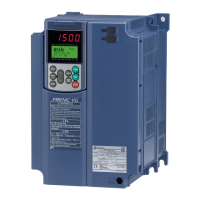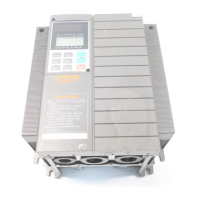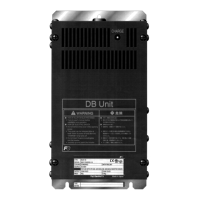4.8 Configuring Function Codes for Drive Controls
4-15
TEST RUN PROCEDURE
Chap 4
[ 3 ] Driving an IM under the V/f control with speed sensor
(1) Configuring the function codes of motor parameters
For details, refer to “4.8.1 [ 1 ] Driving a non-Fuji motor or Fuji non-standard IM under the V/f control.” In addition, if
you use the V/f control with speed sensor, you must set P01:the number of poles.
(2) Configuring the function codes concerning a PG (pulse generator) and PG signals
If “V/f control with speed sensor (F42*=3)”, “V/f control with speed sensor and auto torque boost (F42*=4)” or “Vector
control with speed sensor (F42*=6)” is used, setting of the following function codes is necessary to receive the
rotation direction and speed detection signal from the speed sensor correctly.
For details on how to modify the function code data, see Chapter 3 “3.4.1 Setting up function codes “Data
Setting:
!f__
through
!o__
”.”
Function
Name Function code data
d 14
Feedback input
(Pulse input format)
Pulse input format of motor encoder to be controlled
2: Quadrature A/B signal(B phase lead)
3: Quadrature A/B signal(A phase lead)
* The relation between the motor forward rotation and encoder forward
rotation direction is shown in Figure 4.8-2.
d
15
Feedback input
(Encoder pulse
resolution)
Set “Pulse number of the target motor encoder” in hexadecimal
notation.(Displayed in decimal notation on the multi function keypad)
e.g. 0400 hex. Or 1024 P/R
d
16
Feedback input
(Pulse scaling factor 1)
Reduction ratio between the motor and the encoder
Motor speed =Encoder speed × (d17) / (d16)
These functions are set if the encoder is mounted on the speed
changer/reducer side. If it is directly connected to the motor shaft, the
factory default value “1” does not need to be changed.
d
17
Feedback input
(Pulse
scaling factor 2)
If the rotation direction/speed detection signal from the encoder does not match with the motor rotation
direction, excessive cu
or control with speed sensor (F42*=6), the motor does not reach the set frequency
but rotates slowly at the speed equivalent to the slip frequency. In this case, check that the phase order of
motor wires is correct and the encoder wires are correctly
connected and are not broken.
In 4_17 to 4_18 of I/O check, the number of feedback pulses per second of AB phase and Z phase can be
checked. In 3_29 of the drive monitor, the frequency [Hz] calculated from the speed detection signal from
the encoder can be checked. These are displayed regardless of the control method if the PG option card
is
mounted and the encoder is wired.
It is recommended to check that the rotation direction and speed are correctly detected by rotating the
motor manually or
executing tentative operation by “V/f control (F42*=0)” at first. After that, switch
the
desired control method.
Fuji regards the CCW as the forward rotation direction viewed from the motor output shaft as shown in Figure 4.8-2.
During rotation in the forward direction, the PG output pulse forms a forward rotation signal (B phase leads by 90
degrees) as shown in Figure 4.8-2, and during rotation in the reverse direction, a reverse rotation signal (A phase
lead s by 90 degrees).
In the case of motors other than non-Fuji one, for example, to mount an external PG, directly connected it to the
motor, using a coupling, etc.
Figure 4.8-2 Forward Rotational Direction of Motor and PG (Pulse Generator)
In the case of using motors which comply with IEC standard, their rotation directions are opposite to that in
Figure
A phase input
B phase input

